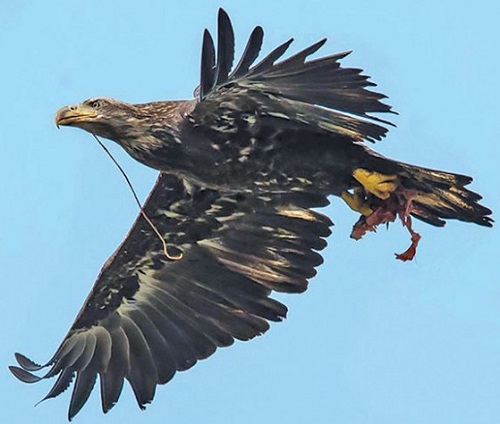 The Conowingo Dam is a hugely popular outdoors destination. Birders flock to the enormous structure that spans the Susquehanna River to watch eagles, herons and a pair of peregrine falcons. Anglers crowd along Fishermen’s Park to cast for walleye and perch. Photographers turn their long lenses across the river to capture stunning images of eagles catching fish or feeding their young.
The Conowingo Dam is a hugely popular outdoors destination. Birders flock to the enormous structure that spans the Susquehanna River to watch eagles, herons and a pair of peregrine falcons. Anglers crowd along Fishermen’s Park to cast for walleye and perch. Photographers turn their long lenses across the river to capture stunning images of eagles catching fish or feeding their young.
But one longtime dam visitor is wondering how long the user groups can co-exist. Dave Lychenheim, who runs the popular Conowingo Bald Eagles Facebook page, has become increasingly concerned that fishing hooks and fishing line are endangering the national bird, as well as the numerous cormorants and herons. Lychenheim and his supporters have launched a campaign to designate Conowingo a “sensitive bird area” and relocate the fishing pier.
To make his case, Lychenheim has sent stunning images of birds tied up in monofilament line to the U.S. Fish and Wildlife Service, the Maryland Department of Natural Resources and the Audubon Society. He has also taken his case to the local media, and several Baltimore-area television stations have done stories.
So far, the responses haven’t been encouraging. David Curson, director of bird conservation for Audubon Maryland-DC, said he could not support a ban on fishing at the dam and suggested an education campaign with more signs. Maryland Department of Natural Resources Assistant Secretary Frank Dawson told Lychenheim that the department has looked into the issue and had no indication that more eagles were dying at Conowingo than at other places. And the U.S. Fish and Wildlife Service’s Craig Koppie agreed “more should be done” to protect eagles, but didn’t offer any specifics.

Lychenheim said the agencies’ lack of concern for the birds has only made him and his group push harder.
“I don’t think birds die in a convenient place,” he said. “I know that this is happening, and everyone that goes there sees this. To me, the DNR sounds like the DMV, or the department of transportation. You know there’s a dangerous intersection, but you won’t do anything until five people are killed.”

Lychenheim frequently posts photos on the Conowingo Bald Eagles Facebook page, which has nearly 9,000 followers all over the world. They show gulls, eagles and cormorants tangled in lines, or flying with lines in their mouths. Once, a fisherman waded into the frigid Susquehanna waters to remove a line from a great blue heron’s mouth. Cormorants are among the most endangered, because they dive deep and pick up line left in the water.
“There are some very striking photographs,” said Jonathan McKnight, associate wildlife director of the Maryland DNR. “We just don’t have any evidence that there’s any significant mortality. If we were looking at major mortality, then we’d be looking hard at finding a solution.”
Eagles were on a path to extinction in the 1960s. The pesticide DDT made their shells thin and breakable, and DDT was banned on June 14, 1972.
But it would be decades before large numbers of eagles again populated the shores of the Chesapeake Bay and elsewhere. By 2007, the birds were so plentiful that the U.S. Fish and Wildlife Service removed them from the federal endangered species list. Three years later, they came off the Maryland list. There are thousands of eagles in Maryland. The largest numbers of the iconic birds are at Blackwater National Wildlife Refuge, Aberdeen Proving Ground and Conowingo Dam. In Virginia, the Rappahannock River National Wildlife Refuge also has a large number of eagles. In Pennsylvania, Hawk Mountain is home to many migrating raptors, including eagles.
But perhaps nowhere are they as concentrated than at the base of the Conowingo Dam, which is a confined area compared with the vast wildlife sanctuaries. (Visitors can’t see the eagles on much of Aberdeen Proving Ground, as it is restricted to military personnel with a high security clearance.)
McKnight said that Conowingo is a private site, and the DNR could not ban fishing there even if it wanted to.
“It’s hard for the photographers to understand why the fishermen are allowed in this area. But it’s perfectly reasonable for fishermen to go where the fish are,” McKnight said. Besides, Exelon built fishermen a large wharf and even named it for fishermen. At this point, it would be extremely difficult to relocate the fishermen or force them to move.
Exelon spokesman Bob Judge said the company has been sensitive to Lychemheim’s concerns. In response, the company has posted signs explaining the dangers of leaving fishing line around and set up special trash cans to dispose of the line so birds can’t get to it.
According to Judge, 273,000 visitors come to the dam each year to fish, watch birds, hike and enjoy the outdoors.
“There has to be a balance, and we strike a good balance between fishermen and photographers,” he said. “We don’t see this as a problem.”
McKnight and Judge both say they admire Lychenheim’s conviction, and they’re glad he cares enough to alert his followers to the problem. Curson, too, praised Lychenheim’s passion in his letter, and said he would be willing to work together to find a solution.
But Lychenheim maintains the best solution is to move the fishermen; a prospect that the agencies and Exelon maintain is unlikely.
“Everyone says they want to protect the bald eagle,” Lychenheim said. “I say, ‘Well, here’s a good place to start.’” By Rona Kobell. Photo by David Lychenheim.
